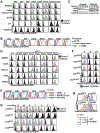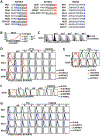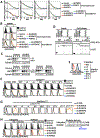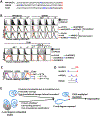C-Terminal End-Directed Protein Elimination by CRL2 Ubiquitin Ligases
- PMID: 29775578
- PMCID: PMC6145449
- DOI: 10.1016/j.molcel.2018.04.006
C-Terminal End-Directed Protein Elimination by CRL2 Ubiquitin Ligases
Abstract
The proteolysis-assisted protein quality control system guards the proteome from potentially detrimental aberrant proteins. How miscellaneous defective proteins are specifically eliminated and which molecular characteristics direct them for removal are fundamental questions. We reveal a mechanism, DesCEND (destruction via C-end degrons), by which CRL2 ubiquitin ligase uses interchangeable substrate receptors to recognize the unusual C termini of abnormal proteins (i.e., C-end degrons). C-end degrons are mostly less than ten residues in length and comprise a few indispensable residues along with some rather degenerate ones. The C-terminal end position is essential for C-end degron function. Truncated selenoproteins generated by translation errors and the USP1 N-terminal fragment from post-translational cleavage are eliminated by DesCEND. DesCEND also targets full-length proteins with naturally occurring C-end degrons. The C-end degron in DesCEND echoes the N-end degron in the N-end rule pathway, highlighting the dominance of protein "ends" as indicators for protein elimination.
Keywords: C-end degron; CRL2 ubiquitin ligase; DesCEND; protein quality control.
Copyright © 2018 Elsevier Inc. All rights reserved.
Conflict of interest statement
DECLRATION OF INTERESTS
The authors declare no competing interests.
Figures







Comment in
-
At Long Last, a C-Terminal Bookend for the Ubiquitin Code.Mol Cell. 2018 May 17;70(4):568-571. doi: 10.1016/j.molcel.2018.05.006. Mol Cell. 2018. PMID: 29775575
References
Publication types
MeSH terms
Substances
Grants and funding
LinkOut - more resources
Full Text Sources
Other Literature Sources
Molecular Biology Databases
Miscellaneous

